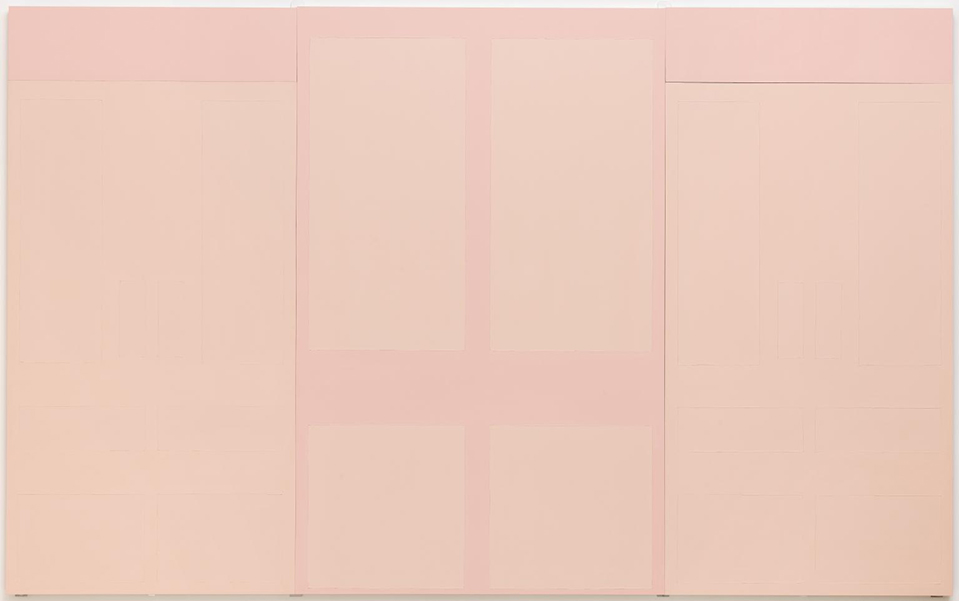Incubus, Alkyd paint on Formica, 2389 x 3846 mm, Garry Hume, 1991.
ncubus is a large, glossy pink painting on five, closely abutting Formica panels. The panels were cut to measurements taken from hospital doors. They are configured to suggest the outline of three, adjacent, life-sized doors. Paler pink, rectangular areas stand out from the background darker pink, delineating panels within the doors. Ridges of paint at the edges of and inside the light pink sections define further rectangles. Hume has explained: ‘the ridges are formed by applying masking tape and draft excluder and building up the edge with several coats of primer. The tape and excluder are then cut away. The gloss colour is applied in one or two layers’ (quoted from unpublished interview with Tate curator Jo Crook). Hume typically uses household gloss paint for its reflective qualities, saying that ‘the high-gloss finish … starts to have a life of its own because it reflects the environment the paintings are shown in … they make you think about light and about where the paintings begin and end’ (quoted in ‘Brilliant’, p.45). Incubus belongs to Hume’s series of Door paintings, made between 1989 and 1991. He has recounted:
I went to St Bartholomew’s Hospital with a tape measure and a piece of paper,
measured numerous doors and made schematic copies of them. I used house paint
in an institutional colour, magnolia, which is a colour of no choice … it was about
democratic use of the symbol of the door. I had to use a totally democratic door.
That’s a hospital door … the institution of the hospital won’t care whether I’m
Gary Hume the artist or Gary Hume the dustman. At the point of crisis I will be
passing through those doors, so I wanted to make them democratic. I’m not
naming the political, but the human.
(Quoted in ‘Brilliant’, p.45.)
Hume is one of the group of young British artists whose careers were launched by the seminal group show Freeze, organised and curated by artist Damien Hirst (born 1965) in London’s Docklands in 1988. A characteristic of the work of artists in this exhibition was the appropriation of everyday objects and subjects. Hume’s contribution was three large canvases covered in mint-white household gloss paint titled Mint Green Doors I-III 1988 (Saatchi Collection, London). Soon after this he abandoned canvas and began painting on MDF board and Formica panels, creating obsessively smooth surfaces and developing the theme of doors. These mainly monochrome and two-colour paintings are literal representations of double swing doors, often with round porthole-style windows, made using the type of paint which is normally used to coat the originals. The paintings explore the difference between the painted and the real.
The doors depicted in Incubus, with their square and rectangular panels, are formally reminiscent of Marcel Duchamp’s semi-ready made sculpture Fresh Widow 1920 (Museum of Modern Art, New York). Consisting of a miniature French window with blacked out panes (covered in black leather) Fresh Widow was remade under the artist’s supervision, scaled up to life-size, in 1964 (Tate T07282). Like Duchamp’s work, Hume’s painting Incubus makes oblique punning reference to the female through its title. The colour pink, traditionally associated with women and flesh, is coupled with the idea of a bad dream. The word ‘incubus’ is defined in the Oxford English Dictionary as ‘a feigned evil spirit or demon supposed to descend upon persons in their sleep and especially to seek carnal intercourse with women’ (quoted from the second edition, 1989). It is also defined as a nightmare, or similar oppression. Another painting of institutional doors made in the same year is titled Dream (private collection).
Hume has likened his shiny, painted surfaces to makeup painted over flesh, querying ‘what is the surface and what is the imagined surface? Where is the skin and where is the flesh? I find myself more and more interested in … discovering where the hierarchies lie, what is above and what is below. How things meet.’ (Quoted in ‘Brilliant’, p.45.) His interest in points of contact and the difference between surface and beneath is aptly expressed using the symbol of the door, itself a threshold or barrier between one space and another.
Further reading:
‘Brilliant’: New Art from London, exhibition catalogue, Walker Art Centre, Minneapolis 1995, pp.42-5
Monique Beudert, Sean Rainbird, Contemporary Art: The Janet Wolfson de Botton Gift, exhibition catalogue, Tate Gallery, London 1998, p.14, reproduced (colour) p.34
Gary Hume: Paintings, exhibition catalogue, Kunsthalle Bern, Institute of Contemporary Arts London 1995, reproduced (colour) pp.20-1
Elizabeth Manchester
May 2002

